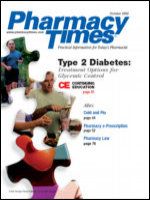Publication
Article
Pharmacy Times
Community Pharmacy Groups Race to Establish E-Prescription Interface
Author(s):
An alliance of the 2 leading pharmacy advocacy groups?the National Association of Chain Drug Stores (NACDS) and the National Community Pharmacists Association (NCPA)?will soon roll out a universal Web interface known as SureScript (www.surescript.com). SureScript will enable every pharmacist in the United States to receive a Web-transmitted prescription from any physician in the country. The interface is a direct competitor to a similar solution being advanced by a pharmacy benefits management group, which is also under development.
?Our goal is to create a direct, secure, and cost-efficient means for prescribers to communicate with pharmacies,? says Craig Fuller, president and CEO of NACDS (www.nacds.org). ?Wide adoption of the SureScript system will improve patient care by reducing the time health professionals spend trying to communicate by telephone, and by decreasing the potential for medical error associated with handwritten prescriptions.? E-Prescribing?Making the First Connections
Some pharmacies, such as Giant (www.giantfood.com), have already begun experimenting with less universal forms of e-prescribing, which enable some doctors in some parts of the country to send e-prescriptions to some pharmacies.
The new Giant Foods e-prescription service, called OnCallData, enables approximately 30,000 doctors to send prescriptions via the Internet to all 146 of Giant?s pharmacies nationwide. ?Over 30% of a pharmacist?s workday is spent on the phone receiving and clarifying prescriptions,? says Russell B. Fair, vice president of pharmacy operations at Giant Food. ?By 2005, retail pharmacists are expected to fill 4 billion prescriptions,? Fair adds. ?This hassle-free service will allow our pharmacists to spend more time counseling patients instead of spending time on the phone answering questions and processing prescriptions.?
A drawback to the Giant system is that its Web interface is not universal. Patients who already shop at Giant will probably raise no objections to physicians who transmit prescriptions electronically to their favorite Giant store. Yet, patients who prefer to use a corner pharmacy that is not Web-enabled?or does not have software that can easily interface with the Giant system?will not be able to benefit from this system. SureScript?Ensuring Universality
It is precisely this lack of universality that SureScript is attempting to overcome, according to Ken Whitte-more, Jr, vice president of professional affairs at SureScript Systems. ?We?re designing SureScript to be accessible to the vast majority of pharmacists and physicians,? he says.
SureScript Systems has the clout to deliver on that promise, given that it was created by NACDS and NCPA (www.ncpa.org), Whittemore says. ?Our organizations, representing all of the nation?s more than 50,000 retail pharmacies, are uniquely positioned to launch a company that can bring the critical mass necessary for electronic connectivity to gain momentum in the marketplace,? says Kevin Hutchinson, SureScript chief executive officer.
Backed by the cooperation of so many pharmacies, Whittemore says that putting the finishing touches on an e-prescription Web interface?which can be easily accessed by the various software programs in use by the country?s pharmacies?does not represent SureScript?s major challenge. Instead, the real stumbling block is ensuring that the SureScript system interfaces with the estimated 50+ software programs that are currently in use in physicians? offices nationwide. To facilitate the transition, SureScript has a representative working with the larger physician organizations, who is trying to smooth the way for seamless SureScript compatibility with physician office software. ?We?re planning some pilot tests of SureScript in the late fall, with a rollout scheduled in early 2003,? Whittemore says.
Another reason that SureScript shows great promise to become the universal Web interface, according to Whittemore, is that it is based on the Script Standard. Developed by the National Council for Prescription Drug Programs (NCPDP; www.ncpdp.org) -a group representing pharmacies, physician software houses, drug wholesalers, pharmacy benefits management (PBMs) companies, and drug database companies?the Script Standard is essentially the ?electronic DNA? that is used by every medical software program that offers an e-prescription application. RxHub?Pharmacy-Friendly?
A competing organization representing the country?s key PBMs?RxHub (www.rxhub.net)-is simultaneously attempting to proliferate its own version of an e-prescription Web interface. RxHub was founded in 2001 by 3 of the leading PBM in the United States?AdvancePCS (www.advance. pcs.com), Express Scripts (www.express-scripts.com), and MedcoHealth (www.merck-medco.com) -to develop the interface.?Each of the companies independently identified a need in the current prescription process,? says Rochelle Woolley, RxHub?s vice president. ?After pursuing solutions individually, the companies determined that founding this joint venture is the best and most efficient way to accelerate the development of an industry-wide-solution.?
Although Woolley says that RxHub is actively soliciting the participation of pharmacies in the development of its own e-prescription Web interface, pharmacy advocates worry that a PBM-controlled Web interface will eliminate the pharmacist from the patient care team?and further erode the market share community pharmacists have vis-`a-vis mail order and Internet-only pharmacies.
?We don?t believe that an e-prescription service that promotes the PBMs is in the best interest of the patient,? says Crystal S. Wright, vice president of media relations for NACDS. As community pharmacists know all too well, PBMs are notorious for pushing name brand drugs as opposed to less expensive generics, she says. Whereas PBMs have the buying power to negotiate cheaper prices from drug manufacturers, they do not always pass those savings on to their customers, she adds.
Perhaps even more worrisome about the popularization of the PBMs is the loss of oversight these competitors introduce into the treatment loop, Wright says. ?Community pharmacists know their customers personally?they know what over-the-counter drugs their customers are taking and how those drugs will interact with a prescription,? she says. ?PBMs have no ability to offer that pharmaceutical care and oversight.?
Given the prospect of a PBM-advocated Web interface proliferating throughout the marketplace, it is incumbent on community pharmacists to ensure that SureScript becomes the preeminent e-prescription interface on the Web, Wright says.










